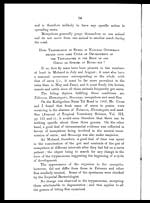Medicine - Veterinary > Civil Veterinary Departments > Indian Civil Veterinary Department memoirs > No. 2 - Collected notes
(188) Page 13
Download files
Individual page:
Thumbnail gallery: Grid view | List view

13
In connection with their work on El debab (trypano-
somiasis of camels in North Africa), Drs. E. and E. Sergent
found that in Algeria it was rarely found on camels. In
Mohand, however, it was not only found in hundreds on
all our camels, but it showed a marked preference for biting
the camel rather than the horse.
This was so pronounced that if a horse was taken into
the proximity of a camel nearly all the flies worrying
the horse would join those already on the camel; the
probable reason is that the camel is an easier prey, for
the panniculus is less developed and the tail is of no use for
switching off flies excepting in the groin; when it is
swarming on him, his only defence is by muscular exertion
with head and feet or by rolling, and he soon tires of
this and eventually lies prostrate on his side, blowing
and occasionally kicking feebly, and, like the horse,
his temperature rises considerably from the exertion and
irritation.
Sand-flies.—Bite most in the late afternoon and evening.
In very wet weather they sometimes covered the sides and
belly of our horses and camels and gave rise to intense
subsequent irritation.
Camels show this by rubbing against trees. It was impos-
sible to tell whether sand-flies usually gorge themselves on
one victim or not.
Mosquitoes.—Bite horses, cattle and buffaloes.
The common species in Mohand were Anopheles,
Culex and Stegomyia. Anopheles and Culex bite chiefly
by night and have a preference for the legs of the horse
and the belly of the camel, although they will bite almost
anywhere; a drop of blood is often left near the bite, but
this is not from the puncture but comes from the anus of
the gorged mosquito. Mosquitoes are difficult to see at
work on animals and are easily missed. When in large
numbers, they give rise to some uneasiness on the part of
the animal attacked.
Stegomyia bites in the day time and has a marked
preference for the ears and brisket of the horse. Males are
found hovering about these situations too, but, of course, only
the females bite. Stegomyia was always scanty in number
Set display mode to: Large image | Zoom image | Transcription
Images and transcriptions on this page, including medium image downloads, may be used under the Creative Commons Attribution 4.0 International Licence unless otherwise stated. ![]()
| India Papers > Medicine - Veterinary > Civil Veterinary Departments > Indian Civil Veterinary Department memoirs > Collected notes > (188) Page 13 |
|---|
| Permanent URL | https://digital.nls.uk/75512468 |
|---|
| Shelfmark | IP/RA.10. |
|---|---|
| Additional NLS resources: | |




